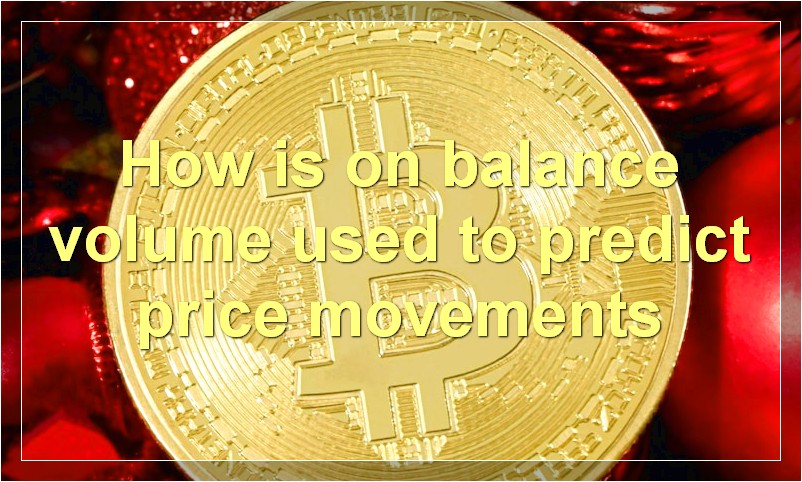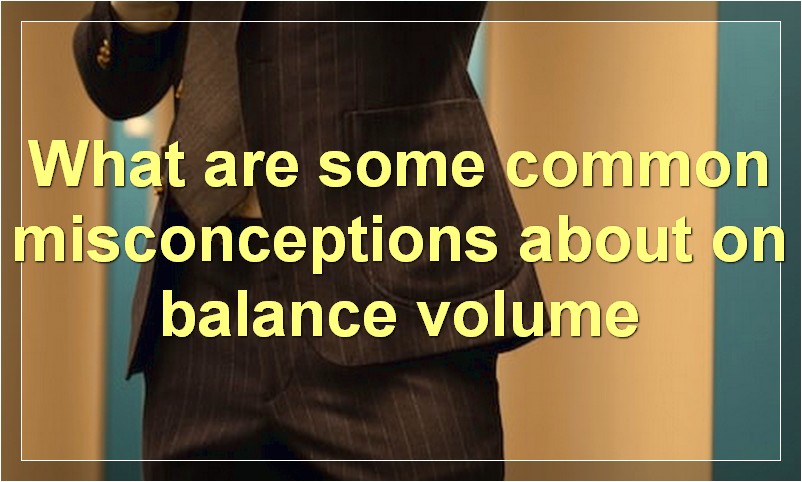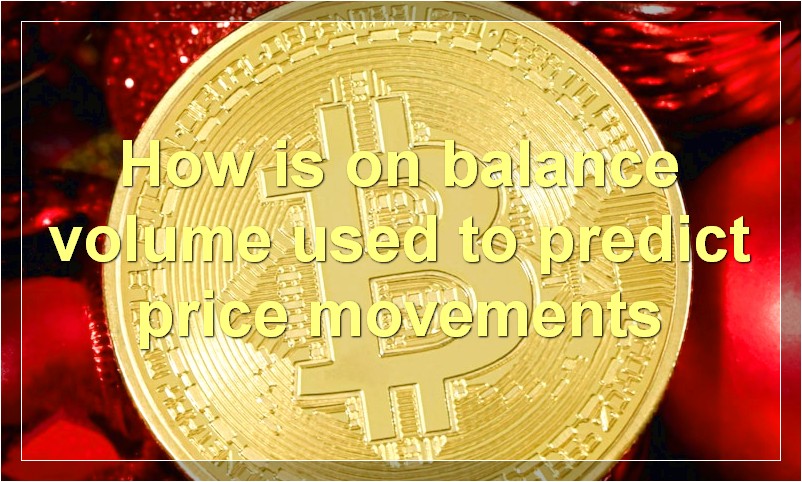If you’re looking to get ahead of the competition in the stock market, then you need to know everything there is to know about on balance volume. This technical indicator is a powerful tool that can help you make informed decisions about when to buy and sell stocks.
What is the purpose of on balance volume
On balance volume, or OBV, is a technical indicator that uses volume information to predict changes in stock price. OBV measures the difference between the amount of volume traded on days when the stock price closes higher than it did the day before (positive volume) and the amount of volume traded on days when the stock price closes lower than it did the day before (negative volume). A rising OBV indicates increasing buying pressure and is generally considered a bullish sign, while a falling OBV indicates increasing selling pressure and is generally considered a bearish sign.
How is on balance volume used to predict price movements

On balance volume is a technical indicator that uses volume to predict future price movements. OBV calculates the cumulative total of volume whether it is up or down. When the OBV is rising, it means that more people are buying than selling, and vice versa. This can be used to predict future price movements, as rising OBV indicates buying pressure and falling OBV indicates selling pressure.
How is on balance volume calculated
On balance volume (OBV) is a technical indicator of momentum, measuring whether volume on up days is heavier than volume on down days. It is calculated by adding the volume on up days and subtracting the volume on down days. A rising OBV indicates increasing buying pressure, while a falling OBV indicates increasing selling pressure.
What are the limitations of using on balance volume
On balance volume is a momentum indicator that uses volume data to show whether buyers or sellers are in control. OBV can be used to spot trends and make predictions about future price movements, but there are some limitations to consider when using this indicator.
One limitation is that on balance volume only considers volume data, while other indicators also take into account price data. This means that OBV may not always give an accurate picture of market conditions.
Another limitation is that on balance volume is a lagging indicator, which means it can take some time for the signal to change after a price change. This means that OBV may not be well suited for short-term trading strategies.
Finally, on balance volume can be affected by things like one-time events or changes in trading activity, which can make it difficult to interpret the signal.
What are some other indicators that can be used in conjunction with on balance volume
On balance volume is a technical indicator that uses volume data to show changes in investor sentiment. It is calculated by taking the difference between the total volume of up days and the total volume of down days, and then adding or subtracting this from the previous period’s OBV.
OBV can be used as a standalone indicator, or in conjunction with other technical indicators, to help confirm price movements and trend reversals. Some other indicators that can be used in conjunction with OBV are moving averages, price momentum indicators, and trendline breakouts.
What are some common misconceptions about on balance volume

On balance volume is a technical analysis indicator, created by Joseph Granville, that uses volume and price to predict changes in the direction of the stock market.
There are a few common misconceptions about on balance volume that we would like to clear up.
1. On balance volume is only useful for stocks.
This is not true! On balance volume can be used for any type of security, including stocks, bonds, ETFs, and even cryptocurrency.
2. On balance volume is only effective in trending markets.
Again, this is not true. On balance volume can be used in any type of market, whether it is trending up, down, or sideways.
3. On balance volume is difficult to interpret.
On balance volume is actually quite easy to interpret. The indicator simply subtracts the volume of days where the security closed lower from the volume of days where the security closed higher. If the resulting number is positive, then it is indicative of bullishness, and vice versa.
4. On balance volume is a lagging indicator.
This is partially true. On balance volume is a leading indicator for changes in trend, but it can also be used as a lagging indicator to confirm trends that have already begun.
How can on balance volume be used to confirm other technical indicators
On balance volume (OBV) is a technical indicator that uses volume data to show changes in buying and selling pressure. OBV is based on the assumption that if volume is increasing while prices are rising, then there is strong buying pressure and prices are likely to continue to rise. Conversely, if volume is increasing while prices are falling, then there is strong selling pressure and prices are likely to continue to fall.
OBV can be used to confirm other technical indicators. For example, if prices are rising and OBV is also rising, this could be confirmation that there is strong buying pressure and prices are likely to continue to rise. Similarly, if prices are falling and OBV is also falling, this could be confirmation that there is strong selling pressure and prices are likely to continue to fall.
What are some strategies for trading with on balance volume
On balance volume is a momentum indicator that uses volume flow to predict changes in stock price. OBV measures the buying and selling pressure of a stock, and is used as a leading indicator to identify potential trend changes.
OBV can be used in conjunction with other technical indicators to provide trade signals. For example, if the OBV is rising while price is flat or falling, this could be a signal that price is about to move higher. Conversely, if the OBV is falling while price is flat or rising, this could be a signal that price is about to move lower.
OBV can also be used to confirm trends. For example, if price is trending higher and the OBV is also rising, this suggests that the trend is strong and likely to continue. Similarly, if price is trending lower and the OBV is also falling, this suggests that the trend is weak and could reverse soon.
The best time frame to use for OBV will depend on the time frame you are trading on. For short-term traders, using a 1-minute or 5-minute chart may be most effective. For longer-term traders, using a daily or weekly chart may be more appropriate.
What are some common mistakes traders make when using on balance volume
There are a few common mistakes that traders make when using on balance volume. First, they may not be correctly interpreting the data. Second, they may be basing their trading decisions too heavily on on balance volume data. Third, they may be using outdated or inaccurate data. Finally, they may be using on balance volume data in isolation, without considering other important factors.
Can on balance volume be used to trade stocks, futures, or other markets
On balance volume is a technical analysis indicator that uses volume to predict changes in stock price. The theory behind on balance volume is that volume precedes price, so if the on balance volume indicator is rising, it means that more people are buying the stock, and the price is likely to go up. Conversely, if the on balance volume indicator is falling, it means that more people are selling the stock, and the price is likely to go down. On balance volume can be used to trade stocks, futures, or other markets.

